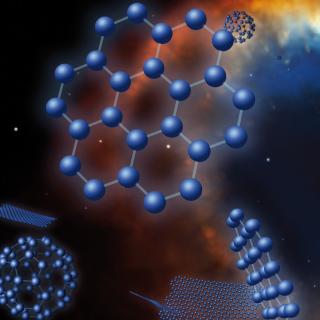Bibcode
García-Hernández, D. A.; Stanghellini, L.; Dell'Agli, F.; Ventura, P.
Referencia bibliográfica
Monthly Notices of the Royal Astronomical Society, Volume 471, Issue 4, p.4648-4661
Fecha de publicación:
11
2017
Número de citas
30
Número de citas referidas
24
Descripción
We study the chemical abundances of a wide sample of 142 Galactic
planetary nebulae (PNe) with good-quality observations, for which the
abundances have been derived more or less homogeneously, thus allowing a
reasonable comparison with stellar models. The goal is the determination
of mass, chemical composition and formation epoch of their progenitors
through comparison of the data with results from asymptotic giant branch
(AGB) evolution. The dust properties of PNe, when available, were also
used to further support our interpretation. We find that the majority
(˜60 per cent) of the Galactic PN studies have nearly solar
chemical composition, while ˜40 per cent of the sources
investigated have subsolar metallicities. About half of the PNe have
carbon star progenitors, in the 1.5 M⊙ < M < 3
M⊙ mass range, which have formed between 300 Myr and 2
Gyr ago. The remaining PNe are almost equally distributed among PNe
enriched in nitrogen, which we interpret as the progeny of M > 3.5
M⊙ stars, younger than 250 Myr, and a group of
oxygen-rich PNe, descending from old (>2 Gyr) low-mass (M < 1.5
M⊙) stars that never became C-stars. This analysis
confirms the existence of an upper limit to the amount of carbon that
can be accumulated at the surface of carbon stars, probably due to the
acceleration of mass-loss in the late AGB phases. The chemical
composition of the present sample suggests that in massive AGB stars of
solar (or slightly subsolar) metallicity, the effects of third dredge-up
combine with hot bottom burning, resulting in nitrogen-rich - but not
severely carbon depleted - gaseous material to be ejected.
Proyectos relacionados

Nucleosíntesis y procesos moleculares en los últimos estados de la evolución estelar
Las estrellas de masa baja e intermedia (M < 8 masas solares, Ms) representan la mayoría de estrellas en el Cosmos y terminan sus vidas en la Rama Asintótica de las Gigantes (AGB) - justo antes de formar Nebulosas Planetarias (NPs) - cuando experimentan procesos nucleosintéticos y moleculares complejos. Las estrellas AGB son importantes
Domingo Aníbal
García Hernández